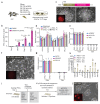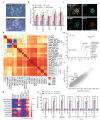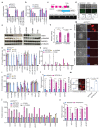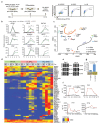Establishment of porcine and human expanded potential stem cells
- PMID: 31160711
- PMCID: PMC7035105
- DOI: 10.1038/s41556-019-0333-2
Establishment of porcine and human expanded potential stem cells
Abstract
We recently derived mouse expanded potential stem cells (EPSCs) from individual blastomeres by inhibiting the critical molecular pathways that predispose their differentiation. EPSCs had enriched molecular signatures of blastomeres and possessed developmental potency for all embryonic and extra-embryonic cell lineages. Here, we report the derivation of porcine EPSCs, which express key pluripotency genes, are genetically stable, permit genome editing, differentiate to derivatives of the three germ layers in chimeras and produce primordial germ cell-like cells in vitro. Under similar conditions, human embryonic stem cells and induced pluripotent stem cells can be converted, or somatic cells directly reprogrammed, to EPSCs that display the molecular and functional attributes reminiscent of porcine EPSCs. Importantly, trophoblast stem-cell-like cells can be generated from both human and porcine EPSCs. Our pathway-inhibition paradigm thus opens an avenue for generating mammalian pluripotent stem cells, and EPSCs present a unique cellular platform for translational research in biotechnology and regenerative medicine.
Figures








Comment in
-
A boost towards totipotency for stem cells.Nat Cell Biol. 2019 Jun;21(6):671-673. doi: 10.1038/s41556-019-0340-3. Nat Cell Biol. 2019. PMID: 31160707 No abstract available.
-
Stem cells with potential.Nat Methods. 2019 Jul;16(7):578. doi: 10.1038/s41592-019-0487-7. Nat Methods. 2019. PMID: 31249416 No abstract available.
-
Modeling the Placenta with Stem Cells.N Engl J Med. 2019 Oct 24;381(17):1681-1683. doi: 10.1056/NEJMcibr1907773. N Engl J Med. 2019. PMID: 31644851 No abstract available.
References
Publication types
MeSH terms
Grants and funding
LinkOut - more resources
Full Text Sources
Other Literature Sources
Research Materials

